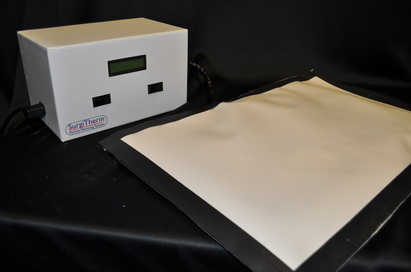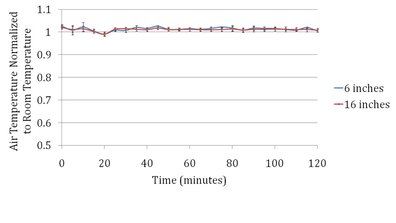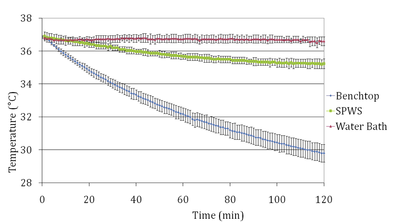SurgiTherm Patient Warming System
System Requirements
Maintain Patient Core Body Temperature
Does Not Interfere With Surgery
Cost Effective
Ensures Surgeon Comfort
Easy to Use
Relays Surface Temperature to Anesthesiologist
Maintain Patient Core Body Temperature
Does Not Interfere With Surgery
Cost Effective
Ensures Surgeon Comfort
Easy to Use
Relays Surface Temperature to Anesthesiologist
Prototype Testing
Ambient Air Temperature
One of the biggest complaints about existing patient warming systems is the warming effect they have on the ambient air temperature. This warming causes surgeon discomfort. To test the effect of the SPWS on ambient air temperature we recorded the change in temperature of the ambient air 6 inches and 16 inches above the surface over 2 hours. There was no statistical difference between the room temperature and the area over the pad during the testing (Figure 2).
Temperature Maintenance of Inert Biofluids
The most effective patient warming methods use circulated warm water to transfer heat to the patients. In order to demonstrate the ability of our project to transfer heat, an inert biofluid model heated to average core body temperature was placed in contact with the SPWS surface. The temperature of the model was monitored over time and the testing was repeated for a water bath at the same temperature as the SPWS and an unheated benchtop. The SPWS maintained the temperature significantly better than the benchtop and was slightly below the efficacy of warm water (Figure 3). While the temperature of the model dropped 1.5 degrees Celsius, we believe that a live model will show little decrease in core body temperature due to metabolic activity and surgical coverings that would be present in a realistic setting
One of the biggest complaints about existing patient warming systems is the warming effect they have on the ambient air temperature. This warming causes surgeon discomfort. To test the effect of the SPWS on ambient air temperature we recorded the change in temperature of the ambient air 6 inches and 16 inches above the surface over 2 hours. There was no statistical difference between the room temperature and the area over the pad during the testing (Figure 2).
Temperature Maintenance of Inert Biofluids
The most effective patient warming methods use circulated warm water to transfer heat to the patients. In order to demonstrate the ability of our project to transfer heat, an inert biofluid model heated to average core body temperature was placed in contact with the SPWS surface. The temperature of the model was monitored over time and the testing was repeated for a water bath at the same temperature as the SPWS and an unheated benchtop. The SPWS maintained the temperature significantly better than the benchtop and was slightly below the efficacy of warm water (Figure 3). While the temperature of the model dropped 1.5 degrees Celsius, we believe that a live model will show little decrease in core body temperature due to metabolic activity and surgical coverings that would be present in a realistic setting



